When is an apple not an apple?
The apple label art of Anne Rook
Anne Rook is a French artist who lives in London. She works in a number of different media including drawing, animation, installation and sculpture and has exhibited around the world. In 2009 she won the Jury Prize at the Sheffield International Book Fair for ‘Apples (Haiku)’. In this article for Apples & People, she explains her fascination with apple labels.
A tiny label stuck on a fridge door started a whole series of works on apples and other fruits. The label was a simple but effective image detailing the type of apple, the country of origin, and the hues that an apple might be. But I was intrigued by the number 4021. Soon many more labels appeared on the fridge, peeled from a variety of apples. A myriad of logos accumulated, all representing different types of apple and other fruits. Each type of apple had a specific number which an internet search told me were PLU numbers.
A PLU (Price Look-Up) number identifies a specific type of fruit or vegetable. It is a world-wide system of identification and was devised for the convenience of supermarkets to safeguard their pricing, and possibly the consumer too.
For instance the PLU number for a Golden Delicious apple is 4021 or, if larger than average, a 4020, irrespective of whether it comes from South Africa, France or the UK. Quite often the origin is not given and the fruit is reduced to a number and an image. The fruits and their labels are ubiquitous. They can be found widely across the globe and at any time of the year; sometimes the same ones in Australia, Greece or Japan.
As my fridge door collection increased, I started to keep a label diary, and still do for labels that are new to me. In the label diary I recorded the date, the type of fruit and the place where I had bought and eaten it. It became a reflection on my habit of buying and eating but also a record of where I had been. It became a travel diary.
My growing collection made me aware of the way in which food is so often hiding under increasingly pretty, appealing, or even elaborate labelling. How else do you explain the image of a dog on a sticker for a French Cassagne Pear or the Mona Lisa for a Spanish Orange?
I began to see these stickers as metaphors, representing worldwide trade and bulk production but also indicating the loss of uniqueness of origin and place. They played with the ideas of cultivation, cultural naturalisation, the natural and the naturalised.
The label works I made over the years are both a concerned comment on our expectations of easy supermarket shopping and of finding fruits in all seasons, and a tongue-in-cheek one on our desires for instant gratification, as in a series of ‘Ready Meals’ I made between 2002 and 2004. The ready ‘Take Away’ meals were printed on clear acrylic and placed in a supermarket box.
My first image of a Golden Delicious apple followed similar paths of thinking and playing with these concepts. The choice of the Golden Delicious is partly because there were so many varied Golden Delicious stickers at the time and partly due to the long history of the apple in religion, mythology and art, from Paris and the Apple of Discord in Greek mythology to Magritte’s ‘Ceci n’est pas une pomme’.
And indeed, ‘Ceci n’est pas une pomme’ would be a good title for the series of images I made of 6 different Golden delicious Apples.
I used a complex process of scanning a label or logo, duplicating it on the computer, printing the resulting sheet on inkjet fine art paper and cutting out its labels one by one. These I pasted individually on a fresh apple, covering it completely.
The logo-covered apple was then photographed, sent to the computer as a flat image so that the physicality of the apple was denied and replaced by an accumulation of labels. Repetition of the logo created the obliteration of the fruit and the result was a constructed apple out of multiple logos representing the apple: it became a ready-made. The ready-made or constructed apple was then printed on draughtsman’s tracing paper, thus emphasising the ‘designed’ aspect of these new apples. In doing this, I hoped to suggest the way in which each variety of apple is now ‘improved’ to satisfy commercial and customers’ requirements of a healthy-looking fruit and of shelf longevity.
The resulting prints were shown in leaflet holders, further removing the apple image from the physicality of a real apple. Later I made an artist’s book out of six of these Golden Delicious prints. I like reworking an image or idea into an artist’s book for two main reasons. First is that it can be handled and leafed through at leisure and, secondly, it can be seen in many different settings, from exhibitions and installations to Artists’ Book Fairs.
The title ‘The Book of 4021 and 4020’ reduced the apples to their PLU number. The clear plastic food container, bought in bulk from a food packaging distributor, in which the book is presented follows the logic of the supermarket PLU.
From an apple to a small apple tree, the step seemed obvious. I obtained small apple tree branches which I trimmed, shaped and covered with Golden Delicious stickers. The resulting ‘trees’ were only 60 to 80 cm high but required some 500 to 800 hand-cut labels.
The repetitive action of cutting out and pasting the stickers on the small trees was an important aspect of the work, in that it paralleled, in very slow motion, the rapid printing of labels and their equally quick stamping on the fruits.
The small trees were then photographed, scanned and arranged to create a ‘Virtual Orchard’.
The print was further manipulated and enlarged to be included in an installation at the Stranger’s Hall Museum in Norwich in 2002, while another variation for the Faculty of Pharmacy in Paris played with the idea of ‘trees’ as the origin of ‘columns’. The Hall of the Pharmacy was re-thought as supported by giant Apple trees.
The concept that apple trees, and therefore the apples that we eat, are all ‘improved’ by the agricultural industry led to other works such as the installations in the Luxembourg Gardens, Paris, and in Brockwell Park, London, where tree trunks were put in ‘straightjackets’ of Golden Delicious labels.
A first trip to Japan had made me aware of how important wrapping, packaging, and presentation are in everyday life. An exhibition in Itami and in Kyoto included a randomly self-renewing animation. On the screen, ten stickers search for their specific apple. When the label hits the right apple, the apple instantly becomes a ‘ready-made’ apple.
The Love Life of Apples, 2006, animation
In another animation an imaginary orchard displays minimalist trees with apples. As apples are hit by labels they mutate into designed ready-made apples. And as they fall, they transform into an empty peeled apple ready for a frustrated potential consumer.
Apple Story, 2014, Animation
Slightly altered, this became a Leporello artist book in which the trees have labels for leaves that transform into ‘designer’ apples. Their subsequent consumption and demise is shown on the reverse side of the book.
This book, together with my other works with apples and labels over the last two decades, form a series of works commenting on the way contemporary economics of agriculture have altered the production of food.
Nature hides itself.

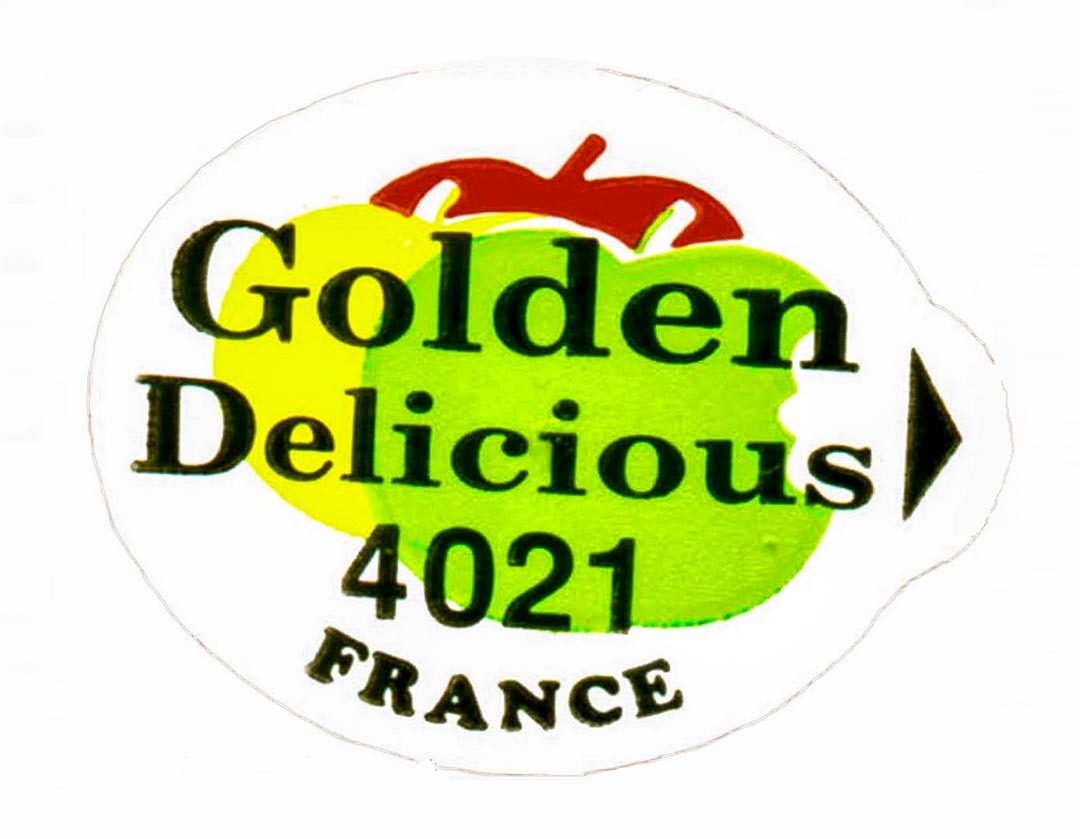
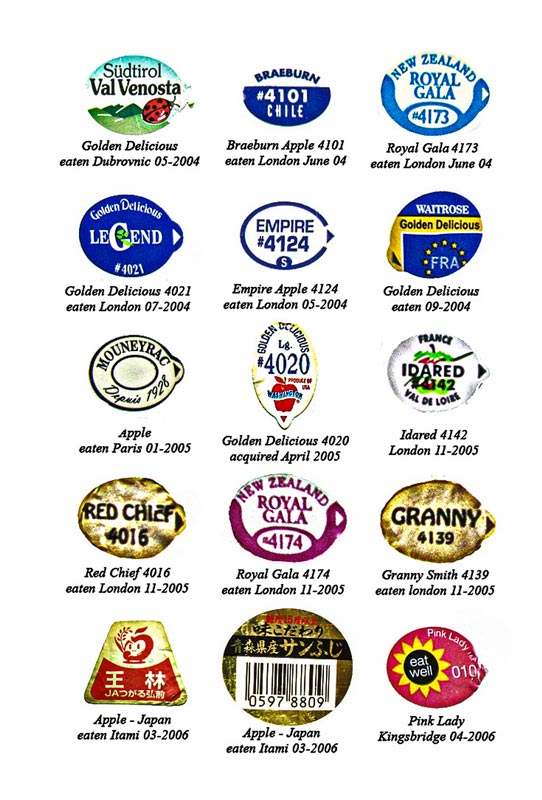
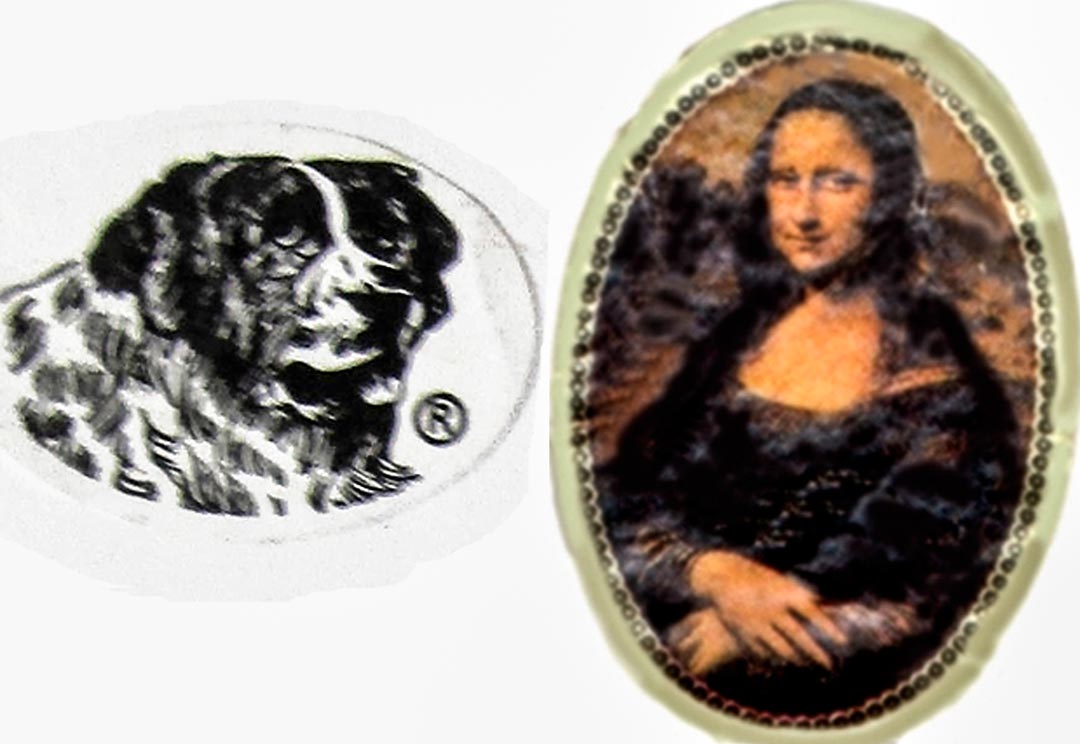



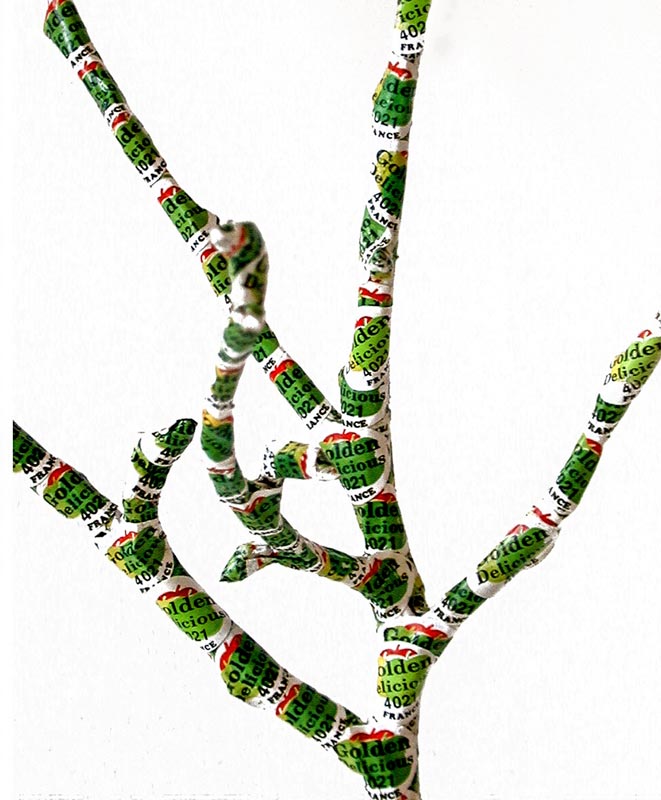
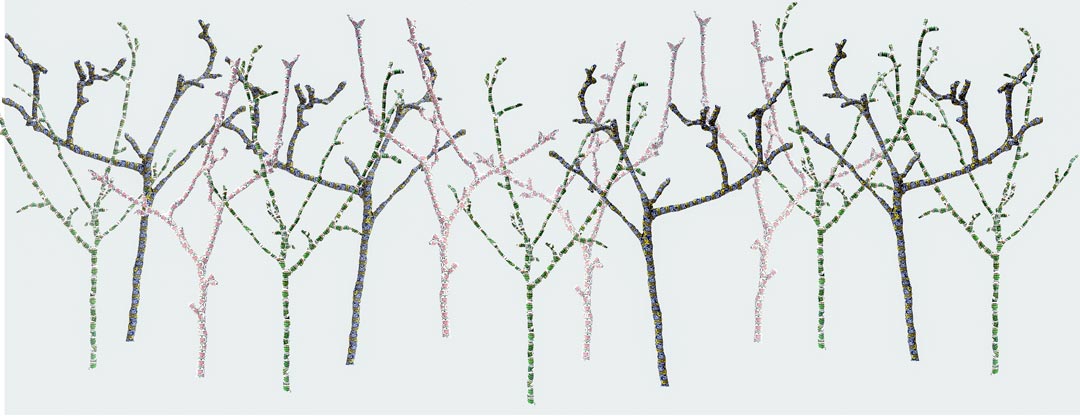




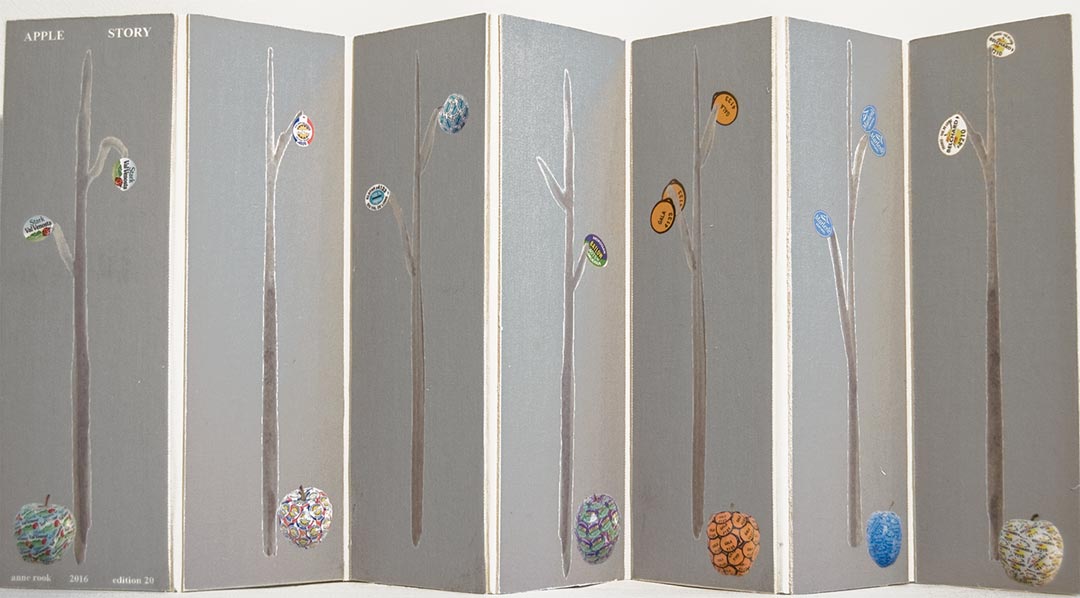
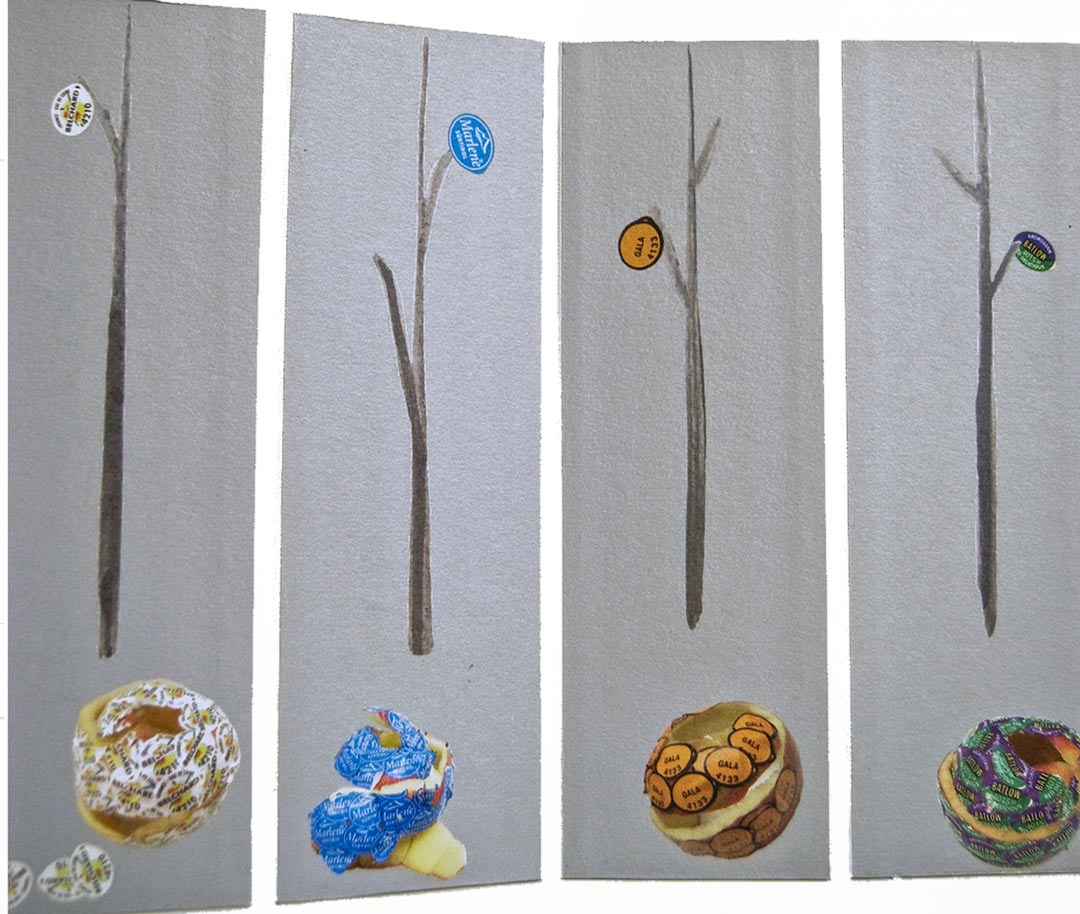




 Malus domestica Schweizer Orangenapfel, Rosaceae, 2022, 90x90x4 cm, oil on linen Photography Dorothea Burkhardt © the artist
Malus domestica Schweizer Orangenapfel, Rosaceae, 2022, 90x90x4 cm, oil on linen Photography Dorothea Burkhardt © the artist ATX 2012 ‘Apple Varieties’
ATX 2012 ‘Apple Varieties’